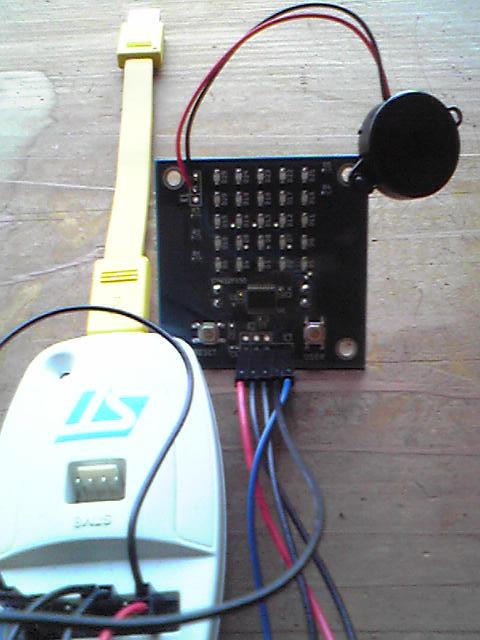August 8th is Happy Hacking Day in Japan, because "Happy Hacking" sounds like 8 8.
This year, I put a speaker to FSM-55 so that we can enjoy some application.
The board
The board is FSM-55 (Flying Stone Mini Go! Go!), which I designed in 2014: http://www.seeedstudio.com/depot/FSM55-LED-Matrix-Display-p-2121.html
Originally, it is a board to fly "Hacker Emblem", but we can enjoy other applications.
Speaker
I bought a speaker of http://akizukidenshi.com/catalog/g/gP-01251/
Then, solder it to the connector K1 2-pin and 3-pin. The GPIO PF1 controls the output to the speaker.
Chopstx and examples
The firmware I put to this board is in the Chopstx distribution:
http://git.gniibe.org/cgit/chopstx/chopstx.git/?id=04a948024aae8cd78db65321ae0b2ee8c1aae0ae
Chopstx is a minimum thread library for such an application.
I develop Chopstx for Gnuk and NeuG, but it is very useful for these particular purposes like flying Hacker Emblem or some toy applications.
The applications are in example-fsm-55/ directory. We have three applications. One is hh.c (the Hacker Emblem), another is debian-logo.c (displaying Debian Logo), and last one is for my children.
I modified the last one to play "Tulip" composed by Takeshi Inoue.
It's simple music. Doe-Ray-Me! The text for music is:
static const char *musical_score = "c4d4e2c4d4e2g4e4d4c4d4e4d2" "c4d4e2c4d4e2g4e4d4c4d4e4c2" "g4g4e4g4a4a4g2e4e4d4d4c2";
We have a thread 'spk' for speaker control and another thread 'music' which interprets musical score and instructs 'spk' thread.
In early 80's, I played something like this with the Intel's chip 8253.
I know that the MCU is powerful enough and it would be even possible to do speach synthesis.
Well, something simpler is better in some cases.
Happy Hacking!
 GNU wannabee and Happy Hacking
GNU wannabee and Happy Hacking
